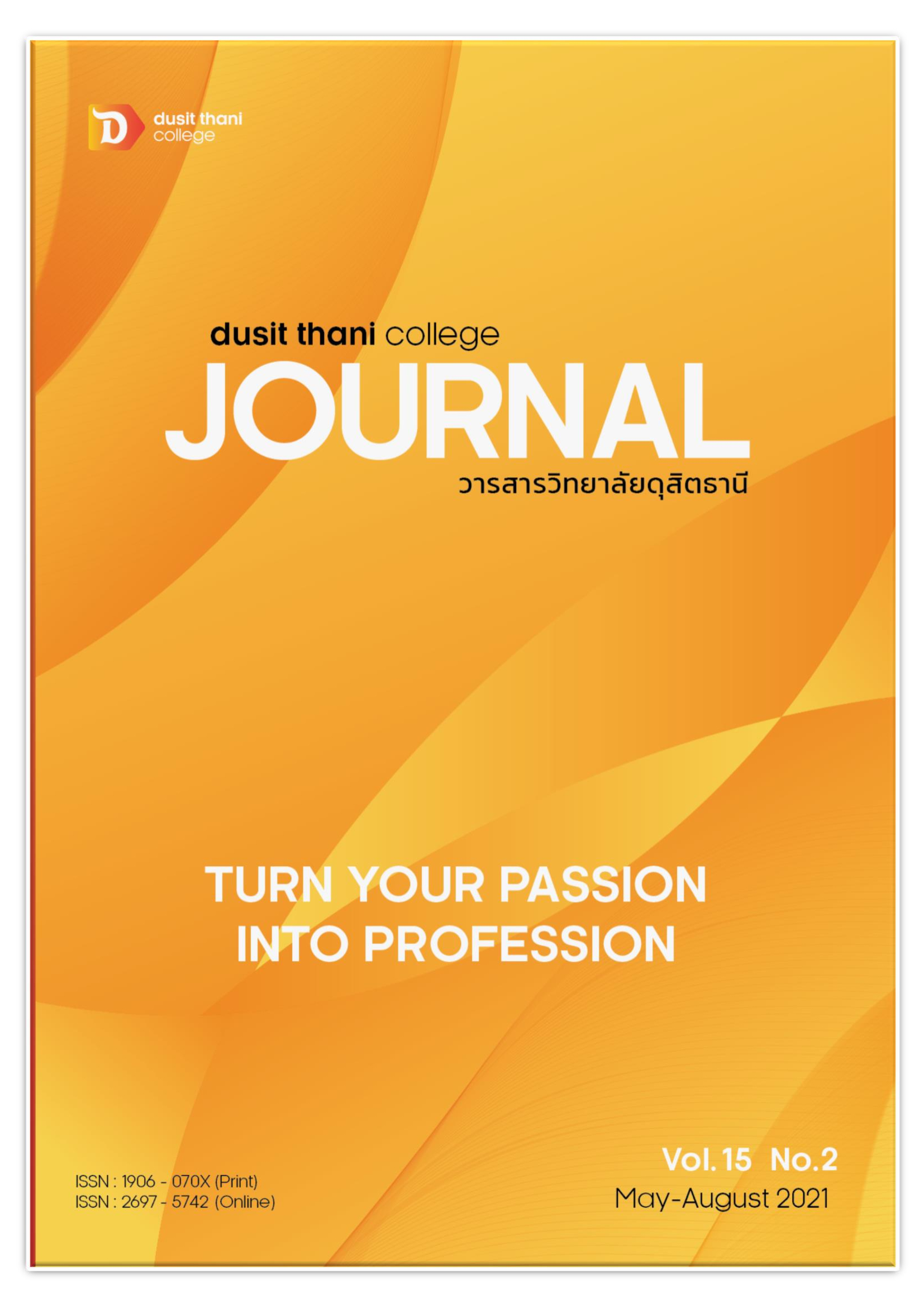SUSTAINABLE FOOD TO SUPPORT HEALTH TOURISM IN BANG KACHAO SAMUT PRAKAN PROVINCE
Main Article Content
Abstract
This article aims to study the status of food in Bang Kachao and to present food menu items based on sustainable food concept to support health tourism in Bang Kachao, Phra Pradaeng District, Samut Prakan Province. The study employed various means for data collection as surveys, questionnaire, informal interviews, focus group, and prototype cooking experiments in the kitchen laboratory and calculating the nutritional value with the program as INMUCAL-Nutrients that was developed by the Institute of Nutrition Mahidol University. The sample are the community leaders, and tourists. The data were analyzed by statistical values (percentage and average) and data analysis technique as data classification.
The results of the study show that the status of food that can be used for cooking include plants, animals, and plant and animals products, divided into 4 categories as: plants -vegetables (edible leaves/flowers); plants-vegetables (edible fruit); fruits; and animals (edible eggs). The community leaders also name 4 categories of local food in Bang Kachao as: savory food; sweet food; snack; and drink. The PTT (Public Company) Limited document divides local food in Bang Kachao into 3 categories as: savory food; sweet food; and snacks.
Sustainable food menu to support health tourism in Bang Kachao including 16 items are: steamed rice cooked with bael juice; steamed rice cooked with Pilang-kasa (Ardisia polycephala) water; steamed fish with herbs; clear soup with pumpkin balls mixed with minced pork and eggs; crispy tofu chili paste; spicy grilled mushroom salad; Taling Pling leaf-wrapped salad bites with ingredients of Taling Pling fruits as main ingredients, cut ginger, toasted coconut, roasted peanuts, shallots, dried shrimp; Khao Tang (rice cracker) topped with mushroom chili paste; Khao Tang (rice cracker) topped with sweet eggplants stir fried with minced pork; Omelet noodles in coconut milk soup with ingredients of shrimp paste, mushrooms, Tremella mushrooms, and dried day lily; porridge served with stir fried Taling Pling mixed with eggs; stir fried tofu with Queen sago; shrimp powder with ingredients of Lanchester’s freshwater prawn, roasted coconut, palm sugar turned back and forth until cooked; whole grain fried rice; and the lotus dessert with sesame filling. These all show sustainability in 4 aspects as: social; economic; environmental; and the health of consumers.
Article Details
Article Screening Policy
- All research and academic articles to be published must be considered and screened by three peer reviews in the relevant field / article.
- All articles, texts, illustrations and tables published in the journal are the personal opinions of the authors. Editors don't always have to agree. And no responsibility whatsoever is the sole responsibility of the author.
- The articles to be published must never be published. Where did you first publish? And not in the consideration of other journals If the audit found that there has been a duplicate publication It is the sole responsibility of the author.
- Any article that the reader sees as being plagiarized or impersonated without reference. Or mislead the work of the author Please let the journal editor know it will be your greatest blessing.
References
Department of Environmental Quality Promotion Ministry of Natural Resources and Environment. Database system for environmentally friendly production and service and consumption. Retrieved October 26, 2019, from https://scpdatacenter.deqp.go.th/articledetail.php?id=3
Isichaikul, Ranee. (2014). Specialized Tourism Management. Nonthaburi, Sukhothai Thammathirat Open University Press.
Kaewanan, Chawisa. (2018) a. Nutrition for the Elderly. Eastern Asia University Academic Journal, Science and Technology edition, 12 (2), 112-119.
_____. (2018) b. Nutrition for the elderly. Eastern Asia University Academic Journal
Science and Technology edition, 12 (2), 112-119. Referred to Leehahul, Buddhadejakhum, & Thaweeboon (2002).
_____. (2018) c. Nutrition for the elderly. Eastern Asia University Academic Journal
Science and Technology edition, 12 (2), 112-119. Referred to the Department of Thai. Traditional and Alternative Medicine. (2014).
_____. (2018) d. Nutrition for the elderly. Eastern Asia University Academic Journal Science and Technology Edition, 12 (2), 112-119. Referred to Durongritthichai, W., Komphayak, J., Lekwijitthada, P., Jinayon, A., & Suwankeereekun, K. (2010).
Hall M. Mitchell R. (2005). Comparing food and wine tourism experience. Gastronomy
Tourism (contemporary).
Pa Sa-la Co., Ltd. (2017). Consumer Demand for Sustainable Seafood: Lessons from Overseas and Analysis of the Gaps in Thailand. Retrieved October 23, 2019, from http://www.salforest.com/knowledge/demand-for-sustainable-seafood
PTT Public Company Limited. (2018). Tamrub (menu) Kung Bang Kachao.
Suwannarak, Thippawan. (2017). Innovative Healthy Food for the Elderly. Eastern Asia University Academic Journal Science and Technology edition, 11 (3), 1-10.
Tangon, Suwajee. (2019). Interviews of villagers. Bang Kachao Community Phra Pradaeng District Samut Prakan Province
Tourism Authority of Thailand. (2008). Knowledge Level of Health Tourism of Thailand Survey Project. Bangkok: Planning Policy Department Tourism Planning Division
Ufuk, A., Gulfer, B., Zehra, A., & Arzu, I. (2012). The International Patient’s Portfolio and Marketing of Turkish Health Tourism. Procedia-Social and Behavioral Sciences. 58, 1004-1007.
Ungprasert, Peerapat, Sirisupalak, Prapinwadee and Lertswawai, Santisaeng. (2018). Food characteristics for Elderly people in Bangkok. 2nd UTCC National Symposium and Academic Presentation Academic Day, June 8, 2018, University of the Thai Chamber of Commerce, page 736-747.
Weragul, Kanokkan et. al. (2013). Gastronomic Tourism. Bangkok, Suan Dusit University.
Water Conservation, Forest Conservation, Bang Kachao Conservation Project. (2019). About Us, People of Khung Bang Ka Chao. Bangkok: Inc. On Paper Co., Ltd.
_____. (2020). Masters of Savory, Sweet Food: Bang Kachao Food. Bangkok: P.O.


